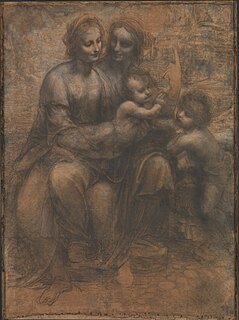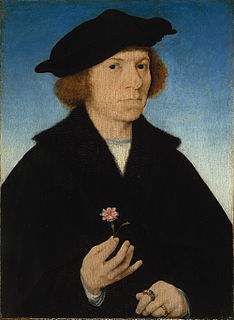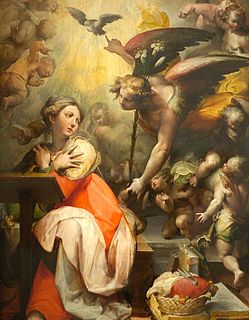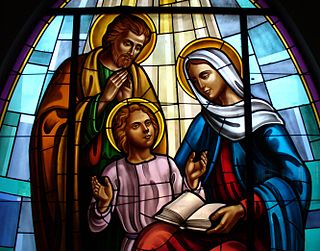
Jacopo Carucci, usually known as Jacopo da Pontormo, Jacopo Pontormo or simply Pontormo, was an Italian Mannerist painter and portraitist from the Florentine School. His work represents a profound stylistic shift from the calm perspectival regularity that characterized the art of the Florentine Renaissance. He is famous for his use of twining poses, coupled with ambiguous perspective; his figures often seem to float in an uncertain environment, unhampered by the forces of gravity.

BartolomeoMontagna was an Italian Renaissance painter who mainly worked in Vicenza. He also produced works in Venice, Verona, and Padua. He is most famous for his many Madonnas and his works are known for their soft figures and depiction of eccentric marble architecture. He is considered to be heavily influenced by Giovanni Bellini, in whose workshop he might have worked around 1470. Benedetto Montagna, a productive engraver, was his son and pupil and active until about 1540. He was mentioned in Vasari's Lives as a student of Andrea Mantegna but this is widely contested by art historians.

Franciabigio was an Italian painter of the Florentine Renaissance. His true name may have been Francesco di Cristofano, however he also is referred to as either Marcantonio Franciabigio or Francia Bigio.

Giovanni Battista Cima, also called Cima da Conegliano, was an Italian Renaissance painter, who mostly worked in Venice. He can be considered part of the Venetian school, though he was also influenced by Antonello da Messina, in the emphasis he gives to landscape backgrounds and the tranquil atmosphere of his works. Once formed his style did not change greatly. He mostly painted religious subjects, often on a small scale for homes rather than churches, but also a few, mostly small, mythological ones.

The Virgin and Child with Saint Anne and Saint John the Baptist, sometimes called The Burlington House Cartoon, is a drawing by Leonardo da Vinci. The drawing is in charcoal and black and white chalk, on eight sheets of paper glued together. Because of its large size and format the drawing is presumed to be a cartoon for a painting. No painting by Leonardo exists that is based directly on this cartoon.

The Calling of Saint Matthew is a masterpiece by Michelangelo Merisi da Caravaggio, depicting the moment at which Jesus Christ inspires Matthew to follow him. It was completed in 1599–1600 for the Contarelli Chapel in the church of the French congregation, San Luigi dei Francesi in Rome, where it remains today. It hangs alongside two other paintings of Matthew by Caravaggio, The Martyrdom of Saint Matthew and The Inspiration of Saint Matthew (1602).

The Doni Tondo or Doni Madonna, is the only finished panel painting by the mature Michelangelo to survive. Now in the Uffizi in Florence, Italy, and still in its original frame, the Doni Tondo was probably commissioned by Agnolo Doni to commemorate his marriage to Maddalena Strozzi, the daughter of a powerful Tuscan family. The painting is in the form of a tondo, meaning in Italian, 'round', a shape which is frequently associated during the Renaissance with domestic ideas.

Joos van Cleve was a painter active in Antwerp around 1511 to 1540. He is known for combining traditional Dutch painting techniques with influences of more contemporary Renaissance painting styles.

The Holy Infants Embracing is a lost painting attributed to Leonardo da Vinci. It represents the infant Christ embracing his cousin John the Baptist. The subject matter relates to the two paintings of the Virgin of the Rocks by Leonardo and numerous other Renaissance works by Raphael and others of the meeting of the two children on the road to Egypt while escaping the Massacre of the Innocents.

The Deposition of Christ is a painting by the Italian artist Agnolo di Cosimo, known as Bronzino, completed in 1545. It is housed in the Musée des Beaux-Arts de Besançon, France. A copy by Bronzino can be found in the Palazzo Vecchio. This portrayal of the Deposition, although it depicts all the characters typically shown when Jesus is being taken down from the cross, more correctly should be characterized as a Lamentation and is an excellent example of late Mannerism or Maniera.

DenisCalvaert was an Antwerp-born Flemish painter, who lived in Italy for most of his life, where he was known as Dionisio Fiammingo or simply Il Fiammingo. Calvaert was a profound student of architecture, anatomy, and history, his works are characterized by their advanced composition and colouring.

Madonna and Child with St. John the Baptist and St. Mary Magdalene is a painting by Neroccio di Bartolomeo de' Landi. The painting is a tempera on wood from 1495. It is currently held by the Indianapolis Museum of Art.

Rebecca and Eliezer at the Well is an oil painting by Italian artist Carlo Maratta, located in the Indianapolis Museum of Art, which is in Indianapolis, Indiana. It shows the story of Abraham's servant Eliezer giving Rebecca jewels to seal her betrothal to Isaac, after she had demonstrated the kindness foreseen by Abraham in offering water to Eliezer's camels.

The Flight into Egypt is a 1635 oil painting by French artist Claude Lorrain, located in the Indianapolis Museum of Art, which is in Indianapolis, Indiana. It depicts the Flight into Egypt, when the Holy Family fled to Egypt to escape Herod's persecution.

Crucifixion is a 1375 panel painting by Italian artist Barnaba da Modena, located in the Indianapolis Museum of Art, which is in Indianapolis, Indiana. It depicts the crucifixion of Jesus in tempera and gold.

Triptych of the Annunciation is a 1483 triptych by the Flemish artist known only as the Master of the Legend of Saint Ursula, located in the Indianapolis Museum of Art, which is in Indianapolis, Indiana. It depicts the Annunciation on the central panel, while the surrounding panels and the outside of the wings are covered in various pairs of male saints.

Entry of Christ into Jerusalem is a 1617 oil painting by Flemish artist Anthony van Dyck, located in the Indianapolis Museum of Art, which is in Indianapolis, Indiana. It depicts Jesus entering Jerusalem as described in the Gospels, the event celebrated on Palm Sunday.

The Madonna and Child with the Infant Saint John the Baptist is a lost composition by Leonardo da Vinci. The composition is known through a handful of paintings attributed to artists in Leonardo's circle. An original underdrawing by Leonardo may be preserved in a version in a private collection in Moscow, Russia.

The Rest on the Flight into Egypt is a subject in Christian art showing Mary, Joseph, and the infant Jesus resting during their flight into Egypt. The Holy Family is normally shown in a landscape.
























